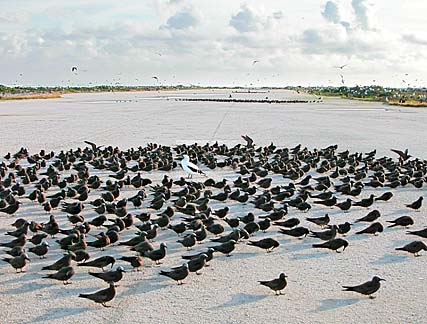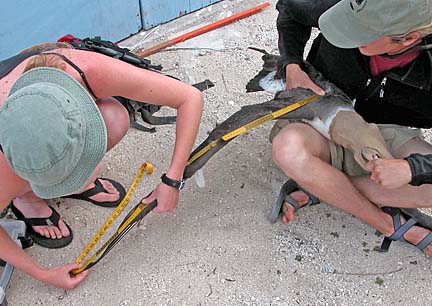
A lone masked booby stands among a flock of brown noddies on Tern Island's runway. At right, several noddies are "nodding," a breeding behavior not fully understood. These ground-nesting birds like this open space but are a hazard to airplanes.
Airstrip links isle to world
Mention a remote field station in Hawaii and a variety of images come to mind. A runway, however, is not usually one of them. Still, on tiny Tern Island, the main biological field station of the Hawaiian Islands National Wildlife Refuge, a white coral runway takes up most of the island.
Such a technological feature seems incongruous for a 34-acre island covered with wildlife, and some people wouldn't mind letting it go to the birds. But the U.S. Fish and Wildlife Service has elected to maintain it. As Tern Island is the hub of Hawaii's remote refuge system, this airstrip is the hub of Tern Island.
"The runway is a mixed blessing," says FWS biologist and former Tern Island resident Alex Wegmann. "The good thing is that it provides access. The bad thing is that with a runway stretching down the middle of it, Tern Island doesn't feel much like a field station."
It's true that the island is less field than station. Besides former military buildings dominating the west end, Tern's airstrip runs nearly the length of the half-mile-long island and takes up more than half its approximately 460-foot width.
It could be said that these structures belong on the island as much as the animals that breed there. For not only are the buildings and runway manmade, so is most of the ground beneath them.
After the bombs fell on Pearl Harbor in 1941, the U.S. Navy needed an airbase at French Frigate Shoals, but the largest piece of land there, Tern Island, measured only 11 acres. Navy builders erected seawalls in a rectangular shape, blasted a channel out of the surrounding reef and used the displaced coral to enlarge the island.
Today, detonating part of a coral reef to build up a Hawaiian island would be controversial enough to practically start another war. It also would be illegal, since both federal and state laws now protect living coral. But it's there now, a manmade coral island smack in the middle of a wildlife refuge.
The U.S. Fish and Wildlife Service retook possession of the island from the U.S. Coast Guard in 1979 and continues to maintain its runway. The reasoning behind this expensive and time-consuming decision is that air travel enables managers, researchers, graduate students, construction workers, volunteers, members of the media and politicians to fly to the atoll.
eople can travel to Tern by boat, and some do, but such voyages are fraught with difficulties. The trip takes two days, one way, through seas notorious for strong winds and big waves. Flying from Honolulu to Tern takes about three hours.
Maintaining a runway is no small task. Tern's biologists grade it, weed it and clear off rocks and debris dropped by breeding seabirds. There are also federal regulations to adhere to. Managers recently used the island's rickety tractor to widen the airstrip, because vegetation had made an illegal claim on some of the edges.
Since 16 species of seabirds nest on the strips of land running down each side of the runway, and the beaches belong to the monk seals and sea turtles, workers use the airstrip as a passageway for their work of monitoring wildlife. Biologists walk, jog and ride bicycles on the runway, and when load-carrying is necessary, they drive their golf cart up and down it.
As long as the FWS can afford to maintain it, Tern Island's wide strip of coral rock will continue to be an intricate part of life on this island, providing a link between people and the animals they care for.
BACK TO TOP |
In addition to monitoring wildlife at Tern Island, U.S. Fish and Widlife Service workers assist researchers with their studies.
Two albatross researchers measure the wingspan and beak length of a Laysan albatross.
The hood they place over the seabird's head helps calm the bird during handling.
A tiny satellite tag is also attached to the albatross's leg to track its fishing route.
Work with wildlife can be
grueling but enjoyable for
biologists and others at Tern
For people who like to work with marine wildlife, Tern Island in French Frigate Shoals is the place to be. Biologists there search for seabird chicks about to fly from their nests and then fasten numbered bands around their legs.Endangered species workers insert tags into the flippers of newly weaned monk seal pups. Field researchers count and document the activity of green sea turtles and their hatchlings.
Such hands-on work is thrilling for wildlife workers, and for most of them, even the dirty parts of it are rewarding. But countless other chores come with the job of monitoring wildlife in the remote islands of the Hawaiian Islands National Wildlife Refuge. And most aren't nearly as appealing as baby birds and tiny turtles.
Take the weeding. Along with banding, tagging and periodically counting animals in the atoll, U.S. Fish and Wildlife Service workers also monitor the spread of alien plants. Plant chores range from simple species counts on the atoll's outer islands and collecting data from specific plots to yanking troublemakers from the ground.
For some, this work is part of being a biologist, and not an unpleasant part. "I like pulling weeds," said Hawaii Kai resident Marcy Okada who recently worked as a volunteer for four months at French Frigate Shoals. "I'm in a beautiful place, surrounded by the ocean and sitting in the middle of nesting seabirds. I feel good after I do it."
Another unglamorous part of wildlife management on a Pacific island is picking up trash that drifts onto beaches. One morning each week, workers collect whatever has washed up and record their finds. Such collecting and record keeping not only rids the beaches of junk, but also lets managers know if drift pollution in the atoll is increasing, decreasing or remaining about the same.
More extensive trash pick-ups occur monthly on Tern because during their offshore forages for food, nesting seabirds pick up just about anything they can carry, including plastic bottle caps, small toys, cigarette lighters and other plastic items they mistake for food. Back on the island, these birds occasionally throw up the indigestible substance. Often, however, they feed it to their chicks, which sometimes throw it up and sometimes do not. When plastic fills a seabird's stomach, it dies of starvation.
Monitoring the health of ecosystems is a main objective in FWS-managed wildlife refuges. For many, this is a fine job, but it means a lot more than counting seals.





